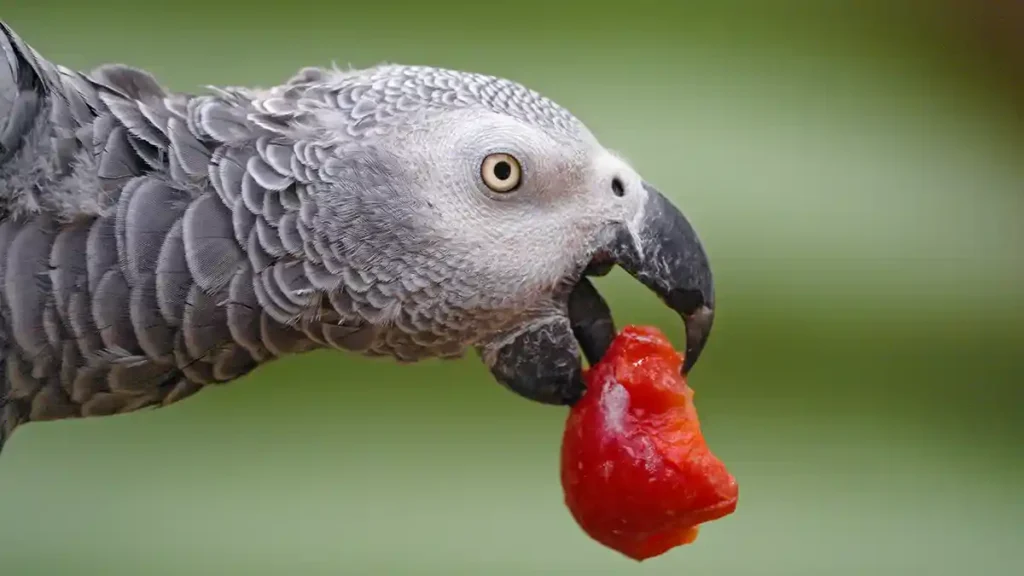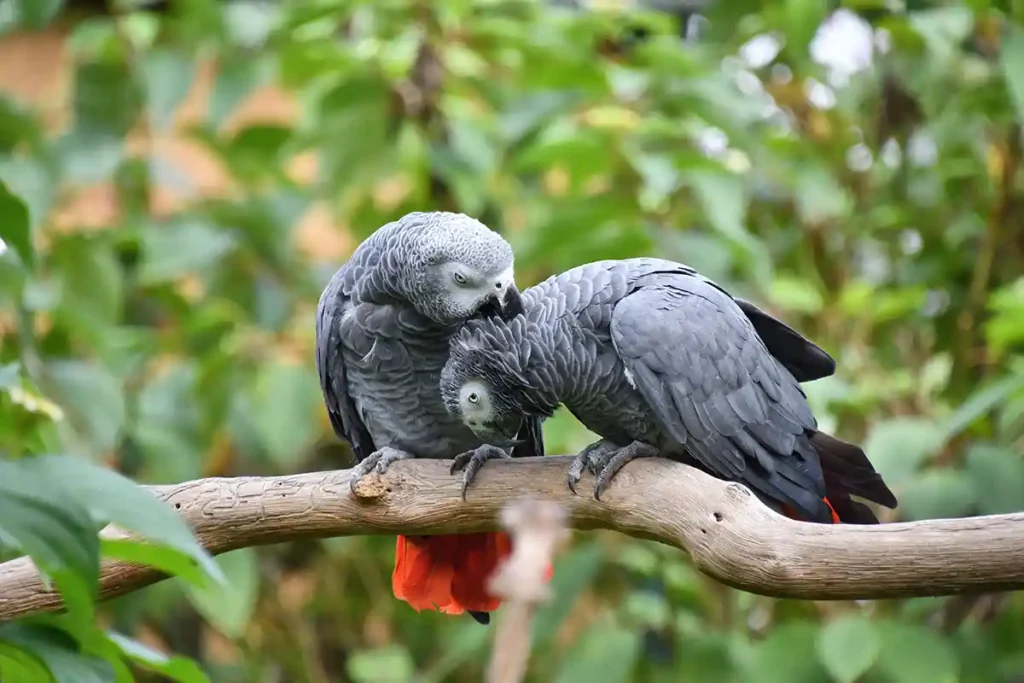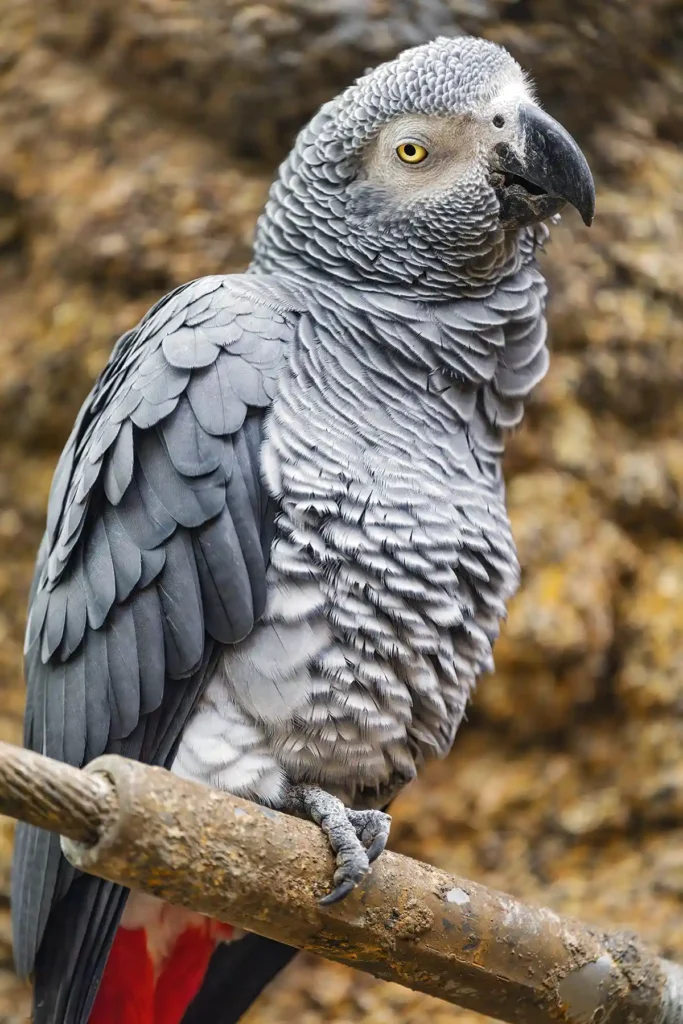
Have you ever met a bird that could hold a conversation? The African grey parrot is one such extraordinary creature. Known for their unparalleled ability to mimic human speech, these parrots are often the star of viral videos and pet shows. But there’s so much more to these intelligent birds than just their impressive talking ability. This article will delve into the fascinating world of the African grey parrot, from their unique behaviors and diet to their conservation status.
Where do African Grey Parrots live?
The grey parrot is a species of avian that calls the rainforests of Central Africa and West Africa its home. From Angola to Cameroon, Congo, Ivory Coast, Ghana, and Kenya, these birds can be found in a variety of regions, including offshore islands in the Atlantic Ocean. Generally, they take to the treetops, where they can easily swoop and forage for food. Although they are mostly grey and have a black bill, they are highly adaptable and can survive in diverse habitats, such as wooded areas, cultivated fields, and plantations.

Congo vs. Timneh African Grey
There are two main subspecies of the African grey parrot: the Congo African grey and the Timneh African grey. The Congo African grey is the more common of the two and is usually what people picture when they think of an African grey. They’re larger in size and have a red tail. On the other hand, the Timneh African grey is smaller and sports a darker, maroon tail.
Appearance
The African grey parrot or Psittacus erithacus, is indeed a sight to behold. It’s easy to see why this species is one of the most popular avian pets across the globe. With its predominantly grey body, the African grey is a medium-sized parrot that stands out due to its bright red tail feathers and intelligent, yellow irises. But what truly sets this parrot apart is the unique scalloped appearance of its head and body feathers, resulting from the slight white edges.
However, the African grey parrot is not a homogenous species. There are two recognized subspecies: the Congo African grey parrot and the Timneh parrot. Both are highly intelligent birds, yet they each have unique physical characteristics that distinguish them from each other.
The Congo African grey parrot is the more commonly recognized of the two. Its plumage is a beautiful silver-grey, and it boasts a red tail that contrasts vividly with its dark grey body. The Congo African grey’s feathers also have a subtle white edging, which gives them a scalloped appearance. This, combined with their intelligent gaze, makes them a captivating sight for bird lovers.
On the other hand, the Timneh parrot, a smaller and darker subspecies of the African grey parrot, offers a different visual appeal. Its feathers are a darker grey, almost charcoal, and instead of a red tail, it sports maroon or dark red tail feathers. It also has a distinct pinkish or horn-colored upper mandible which contrasts with the darker color of the rest of its beak.
Despite these differences, both subspecies share a common trait – their sensitivity. They are known as “sensitive greys” for their propensity to pick at their feathers when stressed or bored. Feather picking, a sign of emotional distress, is a behavior often shown by captive African greys that do not receive enough mental stimulation or physical contact.
These beautiful birds are truly a marvel of the wild population. Their unique appearance, coupled with their highly intelligent nature, makes them stand out among other birds such as macaws, cockatoos, and budgerigars.
Differences in Appearance Between Subspecies
While the overall appearance of the two subspecies is similar, there are some notable differences. The Congo African grey is larger, with a lighter grey body and a bright red tail. The Timneh, on the other hand, is smaller with a darker grey body and a maroon tail.

Diet of the African grey parrot
African grey parrots are omnivores, with a diet consisting mostly of fruits, seeds, and nuts in the wild. They’re also known to enjoy the occasional insect or snail. However, they don’t just eat anything. These birds are picky eaters, often favoring oil palm fruit and preferring fresh foods over dried ones.
Unique Dietary Needs
In captivity, African greys require a diet rich in vitamin A and calcium. Owners often provide a balanced diet consisting of pellets, fresh fruits and vegetables, and a small amount of seeds and nuts. Some of their favorite treats include fresh kale, cooked sweet potato, and nutri-berries.
It’s essential to note that these birds are susceptible to vitamin D deficiency due to their native habitat’s lack of direct sunlight. Therefore, it’s important to supplement their diet with foods rich in beta carotene and to ensure they get ample exposure to sunlight.

Behavior and Intelligence: How intelligent is an African grey parrot?
African grey parrots are often considered the most intelligent species of parrot, if not the most intelligent bird species, period. Their ability to imitate human’s verbal communication is unparalleled in the bird world, with some individuals capable of learning hundreds of words and phrases. But their intelligence goes beyond just parroting back sounds.
Mimicking Human Speech and Other Sounds
African greys have a unique talent for mimicking the sounds they hear around them. They can repeat words and phrases with uncanny accuracy, often in the same voice as the person who originally said them. This ability extends to other sounds as well, such as the ring of a phone, the beep of a microwave, or even other wild bird songs.
Their talking ability is more than just mimicry, though. Research conducted by American scientist Irene Pepperberg with a grey parrot named Alex showed that these birds are capable of understanding and using human language to communicate information. Alex could identify different colors, shapes, and materials and could even count up to six.
Emotional and Mental Capacities
African greys are not just intellectually advanced; they are emotionally complex as well. They form strong social bonds with their flock mates and with humans, often preferring one particular person in a household.
However, their sensitive nature means that they can develop unpleasant habits like feather plucking if they’re stressed or unhappy. This sensitive nature underscores the importance of providing plenty of mental stimulation for these birds, such as puzzle toys and plenty of interaction.
Social Behavior of the African grey parrot
In the wild, African greys live in large flocks, though they form smaller groups or pairs within the larger flock. They’re highly social parrots that spend a lot of time interacting and communicating with their flock mates. They use a range of vocalizations, including contact calls, to communicate.

Reproduction and Lifespan
In the wild, African greys usually mate for life. The female lays three to five eggs in a nest cavity in their own tree, usually high above the ground to avoid predators. Both parents take turns incubating the eggs, and the young leave the nest about 12 weeks after hatching.
African greys have a long lifespan, often living up to 60 years in captivity with proper care. This long lifespan means that owning an African grey is a serious commitment that should not be taken lightly.
African Grey Parrots as Pets
African greys can make excellent pets for the right person. They’re highly intelligent, affectionate, and their talking ability can provide endless entertainment. However, they’re not suitable for everyone.
Pros and Cons of having an African grey parrot
One of the main pros of owning an African grey parrot is their intelligence and interactive nature. They can learn to perform tricks, solve puzzles, and even communicate their needs to their owners.
However, their intelligence and sensitivity also mean that they require a lot of attention and mental stimulation. They can become stressed and develop behavioral problems if they’re neglected or bored.
Unique Needs and Care Requirements
African greys need a large cage that allows them to stretch their wings and move around comfortably. They also require a variety of toys to keep them mentally stimulated.
African greys also require a varied and balanced diet. As mentioned earlier, they need a diet rich in vitamin A and calcium, and they may require supplemental vitamin D.
These birds also need regular social interaction. They bond closely with their owners and can become depressed if they’re left alone for too long.

Training and Socialization
African greys are highly trainable due to their intelligence. They can learn to perform tricks, and they can be taught to talk and mimic a variety of sounds. However, training should always be positive and reward-based, as these sensitive birds can become stressed by harsh training methods.
Socialization is also critical for African greys. They should be exposed to different people, sounds, and experiences from a young age to ensure that they’re well-adjusted and confident birds.
Conservation Status of the African Grey Parrot
Unfortunately, African grey parrots are a threatened species, with their populations in rapid decline. The main threats to these beautiful birds are habitat loss due to deforestation and the international pet trade.
Habitat Loss
The African grey parrot lives in dense forests, coastal mangroves, wooded savannah, and even gardens in equatorial Africa. However, these habitats are being destroyed at an alarming rate, especially in the southeastern Ivory Coast, the central Africa range, and West Africa. This habitat loss is causing a significant decline in wild populations.

The Pet Trade and Its Impact on African Grays
African grey parrots, scientifically known as Psittacus erithacus, are among the most coveted bird species in the international pet trade. Their striking appearance, remarkable intelligence, and unparalleled ability to mimic human speech have contributed to their popularity among bird keepers. However, the high demand for these birds as pets has serious implications for their wild populations.
There are two subspecies of African greys that are primarily targeted in the animal trade: the Congo African grey and the Timneh African grey. While both are undeniably beautiful, they have distinct physical features that set them apart.
The Congo African grey is the larger of the two, with adult birds reaching up to 13 inches in length. They are predominantly grey, with a bright red tail that sharply contrasts against their dark body feathers. This subspecies is known for its stark white eye patches, giving the appearance of wearing spectacles.
On the other hand, the Timneh African grey is slightly smaller, growing up to 11 inches. It sports a darker charcoal grey color, and its tail is a maroon-brown rather than bright red. Unlike its cousin, the Timneh has a light, horn-colored upper mandible and dark grey eye patches.
Most bird keepers can differentiate between the two subspecies at a glance, but to the untrained eye, they can seem quite similar. However, these physical differences are critical identifiers for conservationists who track and monitor wild populations of these birds.
The African greys’ natural habitat spans across various African countries, from the dense forests of the Congo Basin to the forest edges and coastal mangroves of Ivory Coast. They are usually found in pairs or small groups, living in tree cavities lined with tree bark, which provide shelter and a place to nest.
Unfortunately, many African greys never get the chance to live freely in their natural habitat. Every year, thousands of these wild birds, including both adults and young, are captured and sold on the international market. This extensive harvest, when combined with habitat loss due to deforestation, poses a serious threat to their survival.
Another problem that arises from the pet trade is the potential spread of diseases, like Psittacine Beak and Feather Disease (PBFD). This viral disease, which causes feather loss and beak deformities, can be fatal. Infected birds, if reintroduced into the wild, can spread this disease to other African greys, further threatening wild populations.
While african greys are undoubtedly magnificent creatures that captivate most bird keepers, it’s vital to consider the impacts of the trade on these wild birds. Conservation efforts must focus on protecting their natural habitats and regulating the trade to ensure the survival of this remarkable member of the parrot family.

Conservation Efforts
There are many conservation efforts underway to protect and preserve African grey parrots. These include habitat protection, anti-poaching efforts, and breeding programs. However, more needs to be done to ensure the survival of this intelligent and fascinating species.
Wildlife experts are deeply concerned with the vulnerability of this popular pet species. According to the International Union for Conservation of Nature’s Red List (IUCN Red List), their population has seen a dramatic decrease over recent years due to habitat destruction, hunting, and illicit trafficking.
The Alex Foundation, a non-profit organization specializing in parrot conservation, has been actively working towards their protection. Research projects and collaborations with local communities have been conducted to raise awareness and encourage preservation. However, further initiatives are necessary to protect these birds and their habitats.
Illegal trade is one of the foremost dangers to their survival. Highly sought after for their intelligence, vocal imitation, and attractive features, these birds have been targeted and captured for commercial gain, leading to a drastic reduction in their numbers. The Alex Foundation has taken action by partnering with governments and law enforcement to fight against illegal commerce and trafficking.
Additionally, they have been educating the public on the importance of conservation and the adverse effects of illegal trade on wildlife. Thanks to their efforts, many African grey parrots have been rescued, rehabilitated, and released back into their natural habitats.

Rescuing African Grey Parrots
One of the world’s most beloved avian species is in peril. Due to the illegal animal trade, destruction of their natural habitats, and other environmental factors, African grey parrots have seen a dramatic decline in population. Organizations dedicated to their conservation have stepped up to save these birds from traffickers and restore them to health.
In 2011, a group of African greys was rescued from an illegal trader at the Ugandan border. These birds were severely malnourished and some were injured, so they were taken to a rehabilitation center for veterinary care. Once their health was restored, the birds were released into the wild. In cases where the birds had been in captivity too long to survive in the wild, they were taken to sanctuaries.
Not only are conservationists protecting African grey parrots, but also raising awareness about their plight. By highlighting the dangers these birds face, people can help to reduce demand for them as pets and support conservation efforts. Organizations are also educating the public about the importance of protecting these birds and their habitats.
Fun Facts About African Grey Parrots
To conclude our deep dive into the world of African greys, here are a few fun facts about these amazing birds:
- Talented Talkers: Not only can African greys mimic human speech, but they can also understand and use it contextually. One bird, named Alex, was even taught to use phrases like “I want X” and “Wanna go Y,” with X and Y being specific objects or locations.
- Long-Lived: African greys can live up to 60 years in captivity, making them one of the longest-lived parrot species. Some have even been known to outlive their human caretakers!
- Sensitive Souls: African greys are known for their sensitive nature. They can become quite distressed if their environment changes or if they’re not given enough attention. This sensitivity means that they’re not suitable pets for everyone.
- Dietary Diversity: In the wild, African greys eat a wide variety of foods, including seeds, fruits, nuts, and even insects. In captivity, they need a similarly varied diet to stay healthy.
- Brainy Birds: According to research conducted by Brandeis University, African greys have the intelligence level of a 5-year-old child and the emotional capacity of a 2-year-old human.

Conclusion
In conclusion, African grey parrots are fascinating birds that are native to the rainforests of central Africa. They are known for their predominantly grey color and black bill, and there are two species: Congo grey parrots and Timneh grey parrots. Despite their beauty, African grey parrots are listed as vulnerable on the conservation status, and they have been the victims of illegal trading.
However, there is hope for these birds as more people become aware of their plight and take action to protect them. So, let’s spread the word about African grey parrots and post Instagram photos of these amazing creatures to raise awareness. Together, we can make a difference and ensure that African grey parrots continue to thrive in the wild.
